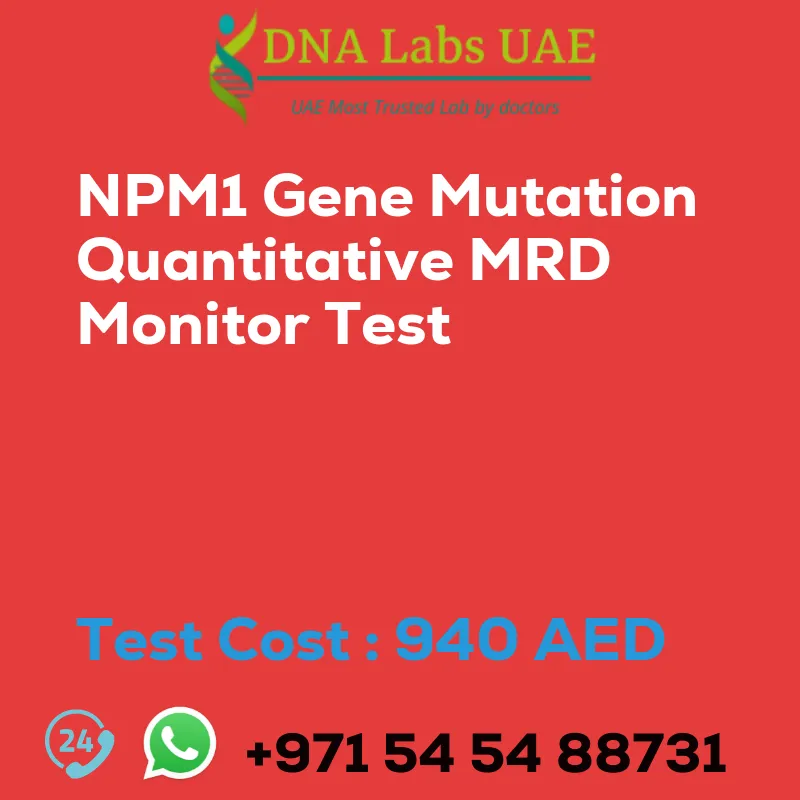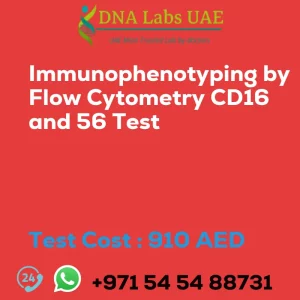NPM1 GENE MUTATION QUANTITATIVE MRD MONITOR Test
Test Cost: AED 940.0
Test Name: NPM1 GENE MUTATION QUANTITATIVE MRD MONITOR Test
Components:
- Price: 940.0 AED
- Sample Condition: 5 mL (3 mL min.) whole blood / Bone marrow in 1 Lavender Top (EDTA) tube. Ship refrigerated. DO NOT FREEZE.
- Duly filled MRD Requisition form (Form 22) with historical data is mandatory.
Report Delivery: SampleMon / Thu by 11 am; Report Wed / Sat
Method: Real Time PCR
Test Type: Leukemia
Doctor: Hematologist, Oncologist
Test Department: MOLECULAR DIAGNOSTICS
Pre Test Information: Duly filled MRD Requisition form (Form 22) with historical data is mandatory.
Test Details
The NPM1 gene mutation quantitative MRD monitor test is a diagnostic tool used to monitor minimal residual disease (MRD) in patients with acute myeloid leukemia (AML) who have a mutation in the NPM1 gene.
The NPM1 gene mutation is a common genetic abnormality found in approximately 30% of AML cases. It is associated with a favorable prognosis and is often used as a marker for MRD monitoring.
MRD refers to the small number of cancer cells that may remain in a patient’s body after treatment, even when no cancer cells are detectable by standard tests. Monitoring MRD is important as it can help assess the effectiveness of treatment and predict the likelihood of relapse.
The NPM1 gene mutation quantitative MRD monitor test uses molecular techniques to detect and quantify the presence of NPM1 gene mutations in a patient’s blood or bone marrow samples. It can provide a more sensitive and accurate assessment of MRD compared to traditional methods.
By monitoring the levels of NPM1 gene mutations over time, the test can help clinicians determine if a patient is responding to treatment or if there is a risk of relapse. This information can guide treatment decisions and potentially improve patient outcomes.
Overall, the NPM1 gene mutation quantitative MRD monitor test is a valuable tool in the management of AML patients with NPM1 gene mutations, providing important information for treatment planning and monitoring disease progression.
| Test Name | NPM1 GENE MUTATION QUANTITATIVE MRD MONITOR Test |
|---|---|
| Components | |
| Price | 940.0 AED |
| Sample Condition | 5 mL (3 mL min.) whole blood \/ Bone marrow in 1 Lavender Top (EDTA) tube. Ship refrigerated. DO NOT FREEZE. Duly filled MRD Requisition form (Form 22) with historical data is mandatory. |
| Report Delivery | SampleMon / Thu by 11 am; Report Wed / Sat |
| Method | Real Time PCR |
| Test type | Leukemia |
| Doctor | Hematologist, Oncologist |
| Test Department: | MOLECULAR DIAGNOSTICS |
| Pre Test Information | Duly filled MRD Requisition form (Form 22) with historical data is mandatory. |
| Test Details |
The NPM1 gene mutation quantitative MRD monitor test is a diagnostic tool used to monitor minimal residual disease (MRD) in patients with acute myeloid leukemia (AML) who have a mutation in the NPM1 gene. The NPM1 gene mutation is a common genetic abnormality found in approximately 30% of AML cases. It is associated with a favorable prognosis and is often used as a marker for MRD monitoring. MRD refers to the small number of cancer cells that may remain in a patient’s body after treatment, even when no cancer cells are detectable by standard tests. Monitoring MRD is important as it can help assess the effectiveness of treatment and predict the likelihood of relapse. The NPM1 gene mutation quantitative MRD monitor test uses molecular techniques to detect and quantify the presence of NPM1 gene mutations in a patient’s blood or bone marrow samples. It can provide a more sensitive and accurate assessment of MRD compared to traditional methods. By monitoring the levels of NPM1 gene mutations over time, the test can help clinicians determine if a patient is responding to treatment or if there is a risk of relapse. This information can guide treatment decisions and potentially improve patient outcomes. Overall, the NPM1 gene mutation quantitative MRD monitor test is a valuable tool in the management of AML patients with NPM1 gene mutations, providing important information for treatment planning and monitoring disease progression. |








